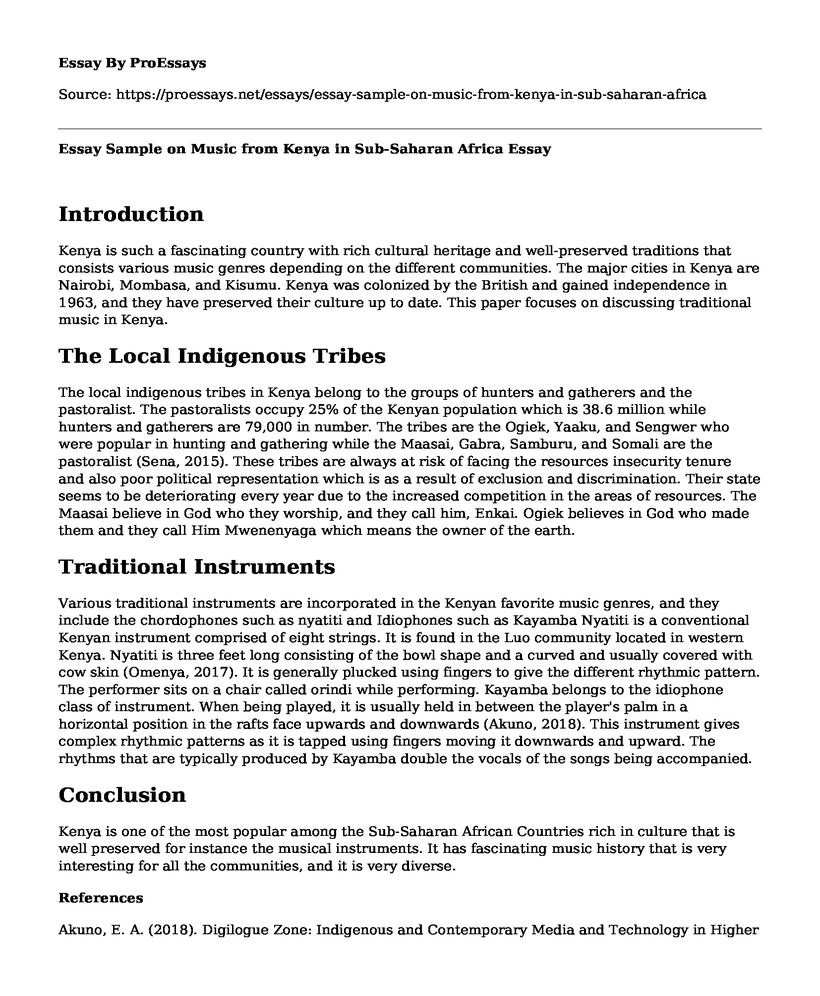Introduction
Kenya is such a fascinating country with rich cultural heritage and well-preserved traditions that consists various music genres depending on the different communities. The major cities in Kenya are Nairobi, Mombasa, and Kisumu. Kenya was colonized by the British and gained independence in 1963, and they have preserved their culture up to date. This paper focuses on discussing traditional music in Kenya.
The Local Indigenous Tribes
The local indigenous tribes in Kenya belong to the groups of hunters and gatherers and the pastoralist. The pastoralists occupy 25% of the Kenyan population which is 38.6 million while hunters and gatherers are 79,000 in number. The tribes are the Ogiek, Yaaku, and Sengwer who were popular in hunting and gathering while the Maasai, Gabra, Samburu, and Somali are the pastoralist (Sena, 2015). These tribes are always at risk of facing the resources insecurity tenure and also poor political representation which is as a result of exclusion and discrimination. Their state seems to be deteriorating every year due to the increased competition in the areas of resources. The Maasai believe in God who they worship, and they call him, Enkai. Ogiek believes in God who made them and they call Him Mwenenyaga which means the owner of the earth.
Traditional Instruments
Various traditional instruments are incorporated in the Kenyan favorite music genres, and they include the chordophones such as nyatiti and Idiophones such as Kayamba Nyatiti is a conventional Kenyan instrument comprised of eight strings. It is found in the Luo community located in western Kenya. Nyatiti is three feet long consisting of the bowl shape and a curved and usually covered with cow skin (Omenya, 2017). It is generally plucked using fingers to give the different rhythmic pattern. The performer sits on a chair called orindi while performing. Kayamba belongs to the idiophone class of instrument. When being played, it is usually held in between the player's palm in a horizontal position in the rafts face upwards and downwards (Akuno, 2018). This instrument gives complex rhythmic patterns as it is tapped using fingers moving it downwards and upward. The rhythms that are typically produced by Kayamba double the vocals of the songs being accompanied.
Conclusion
Kenya is one of the most popular among the Sub-Saharan African Countries rich in culture that is well preserved for instance the musical instruments. It has fascinating music history that is very interesting for all the communities, and it is very diverse.
References
Akuno, E. A. (2018). Digilogue Zone: Indigenous and Contemporary Media and Technology in Higher Music Education in Kenya. Action, Criticism & Theory for Music Education, 17(1).
Omenya, G. O. (2017). Changing trends of gender participation in Luo music. Journal of Gender, Information and Development in Africa (JGIDA), 6(1-2), 45-72.
Sena, K. (2015). Carbon credit schemes and indigenous peoples in Kenya: a commentary. Ariz. J. Int'l & Comp. L., 32, 257.
Cite this page
Essay Sample on Music from Kenya in Sub-Saharan Africa. (2022, Oct 29). Retrieved from https://proessays.net/essays/essay-sample-on-music-from-kenya-in-sub-saharan-africa
If you are the original author of this essay and no longer wish to have it published on the ProEssays website, please click below to request its removal:
- Essay Example on the White-African American Achievement Gap
- Sexual Harassment in Public Places: Experience of Canadian Women
- Essay Example on Music: Essential Tool of Human Life
- Essay Example on U.S. Supreme Court Ignores Film Industry's Artistry Until Oscars
- Essay Example on Empowering People with Disabilities: Making Travel Easier
- Essay Example on US-North Korea Relations Deteriorate: Nuclear Weapons & Missile Developments
- Reimagining Aladdin: Cultural Depictions, Character Transformations, and the American Dream in Animation - Free Essay







